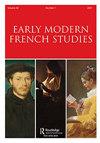蒙田随笔中的中间作者
IF 0.2
3区 历史学
Q2 HISTORY
引用次数: 1
摘要
回到蒙田在其著作中著名的“同体性”主张,本文考察了作者在Essais中的地位。它提出蒙田构建了一种作者的“双重性”,一种静态文本产生多重阅读的技术,这取决于我们如何以及与谁联系“作者”的角色。在“向莱蒙德·塞邦道歉”的结尾,蒙田默默地转录了普鲁塔克的“Que signoit ce mot E'i”中的一段很长的段落,内容涉及所有事物的内在变化,包括思想和判断。这是一个案例研究,旨在展示蒙田如何破坏“作者”的概念,将“作者”转移到页面的中间空间,并允许多个作者在我们改变视角时进入和离开焦点。这种文本的多元性无疑为蒙田提供了一种新的写作方式,即构建一种“形式”。本文章由计算机程序翻译,如有差异,请以英文原文为准。
In-Between Authorship in Montaigne’s Essais
Returning to Montaigne’s famous claim of ‘consubstantiality’ with his book, this article examines the place of authorship in the Essais. It proposes that Montaigne constructs an authorial ‘doubleness’, a technique by which static text yields multiple readings depending on how and with whom we associate the role of ‘authorship’. At the close of the ‘Apologie de Raimond Sebond’, Montaigne silently transcribes a lengthy passage from Plutarch’s ‘Que signifioit ce mot E’i’ on the inherent flux of all things, including thought and judgement. This is taken as a case study to show how Montaigne destabilises the notion of the ‘autheur’, moving ‘authorship’ to the in-between space of the page and allowing multiple authors to come in and out of focus as we change our perspective. This textual plurality provides Montaigne with a new way of writing doubtfully, of constructing a ‘forme d’escrire douteuse et irresolue’.
求助全文
通过发布文献求助,成功后即可免费获取论文全文。
去求助
来源期刊

Early Modern French Studies
Multiple-
CiteScore
0.10
自引率
0.00%
发文量
14
期刊介绍:
Early Modern French Studies (formerly Seventeenth-Century French Studies) publishes high-quality, peer-reviewed, original articles in English and French on a broad range of literary, cultural, methodological, and theoretical topics relating to the study of early modern France. The journal has expanded its historical scope and now covers work on the sixteenth, seventeenth, and eighteenth centuries. Within this period of French literary and cultural history, the journal particularly welcomes work that relates to the term ''early modern'', as well as work that interrogates it. It continues to publish special issues devoted to particular topics (such as the highly successful 2014 special issue on the cultural history of fans) as well as individual submissions.
 求助内容:
求助内容: 应助结果提醒方式:
应助结果提醒方式:


